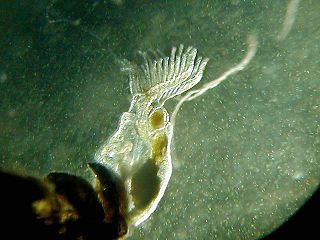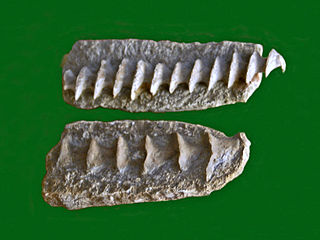
Bryozoa are a phylum of simple, aquatic invertebrate animals, nearly all living in sedentary colonies. Typically about 0.5 millimetres long, they have a special feeding structure called a lophophore, a "crown" of tentacles used for filter feeding. Most marine bryozoans live in tropical waters, but a few are found in oceanic trenches and polar waters. The bryozoans are classified as the marine bryozoans (Stenolaemata), freshwater bryozoans (Phylactolaemata), and mostly-marine bryozoans (Gymnolaemata), a few members of which prefer brackish water. 5,869 living species are known. At least, two genera are solitary ; all the rest are colonial.

A reef is a ridge or shoal of rock, coral or similar relatively stable material, lying beneath the surface of a natural body of water. Many reefs result from natural, abiotic processes—deposition of sand, wave erosion planing down rock outcrops, etc.—but there are also reefs such as the coral reefs of tropical waters formed by biotic processes dominated by corals and coralline algae, and artificial reefs such as shipwrecks and other anthropogenic underwater structures may occur intentionally or as the result of an accident, and sometimes have a designed role in enhancing the physical complexity of featureless sand bottoms, to attract a more diverse assemblage of organisms. Reefs are often quite near to the surface, but not all definitions require this.
Stenolaemata are a class of exclusively marine bryozoans. Stenolaemates originated and diversified in the Ordovician, and more than 600 species are still alive today. All extant (living) species are in the order Cyclostomatida, the third-largest order of living bryozoans.

Cheilostomatida, also called Cheilostomata, is an order of Bryozoa in the class Gymnolaemata.

Cyclostomatida, or cyclostomata, are an ancient order of stenolaemate bryozoans which first appeared in the Lower Ordovician. It consists of 7+ suborders, 59+ families, 373+ genera, and 666+ species. The cyclostome bryozoans were dominant in the Mesozoic; since that era, they have decreased. Currently, cyclostomes seldom constitute more than 20% of the species recorded in regional bryozoan faunas.
Hederellids are extinct colonial animals with calcitic tubular branching exoskeletons. They range from the Silurian to the Permian and were most common in the Devonian period. They are more properly known as "hederelloids" because they were originally defined as a suborder by Bassler (1939), who described about 130 species. Although they have traditionally been considered bryozoans, they are clearly not because of their branching patterns, lack of an astogenetic gradient, skeletal microstructure, and wide range in tube diameters. Work continues on assessing the true affinities of hederelloids, but they appear to be most closely related to phoronids and other lophophorates.
The ascus is a diagnostic morphological feature of the bryozoan suborder Ascophora. It is a water-filled sac of frontal membrane opening (ascopore) at or near the zooid orifice. It functions as a hydrostatic system by allowing water into the space below the inflexible, calcified frontal wall when the zooid everts its polypide by muscles pulling the frontal membrane inwards. The ascus, along with a calcified frontal shield, define ascophoran bryozoa.

Phylactolaemata is a class of the phylum Bryozoa whose members live only in freshwater environments. Like all bryozoans, they filter feed by means of an extensible "crown" of ciliated tentacles called a lophophore, and like nearly all bryozoans, they live in colonies, each of which consists of clones of the founding member. Unlike those of some marine bryozoans, phylactolaemate colonies consist of only one type of zooid, the feeding forms known as autozooids. These are supported by an unmineralized "exoskeleton" made of gelatinous material or protein, secreted by the zooids. The class contains only one extant order, Plumatellida.

The Ctenostomatida are an order of bryozoans in the class Gymnolaemata. The great majority of ctenostome species are marine, although Paludicella inhabits freshwater. They are distinguished from their close relatives, the cheilostomes, by their lack of a calcified exoskeleton. Instead, the exoskeleton is chitinous, gelatinous, or composed only of a soft membrane, and always lacks an operculum. Colonies of ctenostomes are often composed of elongated, branch-like stolons, although more compact forms also exist.

Archimedes is a genus of bryozoans belonging to the family Fenestellidae. The first use of the term "Archimedes" in relation to this genus was in 1838.

Trepostomatida is an extinct order of bryozoans in the class Stenolaemata. Trepostome bryozoans possessed mineralized calcitic skeletons and are frequently fossilized; some of the largest known fossilized bryozoan colonies are branching trepostomes and massive dome-shaped trepostomes. Trepostomes did not have many specialized zooecia beyond ordinary feeding autozooecia. The two main known heteromorphs are exilazooecia and mesozooecia, which had the purpose of maintaining regular spacing between autozooecia.

Cystoporata, also known as Cystoporida or cystoporates, are an extinct order of Paleozoic bryozoans in the class Stenolaemata. Their fossils are found from Ordovician to Triassic strata.
Fenestrata is an extinct order of bryozoan, dating from the Upper Arenig. Most fenestrate bryozoans formed net-like colonies, often in funnel- or fan-shaped forms, with a single layer of zooids facing one direction. The colony shape served as a filter-feeding apparatus that water currents flowed through, with autozooecial apertures only on the side of the colony facing into the current. This colony structure was vulnerable to predators, so some fenestrate bryozoans produced skeletal superstructures, likely to strengthen or protect the colony, and others had protective spines surrounding their autozooecial apertures.
Clausotrypa is an extinct genus of prehistoric bryozoans in the family Nikiforovellidae. The species C. elegans is from a Wordian (Permian) marine horizon in the Sijiashan Formation of Northeast China.

Electra posidoniae is a species of bryozoan in the family Electridae. It is endemic to the Mediterranean Sea, and is commonly known as the Neptune-grass bryozoan because it is exclusively found growing on seagrasses, usually on Neptune grass, but occasionally on eelgrass.
Callopora lineata is a species of colonial bryozoan in the family Calloporidae. It is found on rocky shores in the Atlantic Ocean and the Mediterranean Sea.
Septopora is an extinct genus of bryozoan belonging to the order Fenestrida. It has been found in Pennsylvanian to Permian beds in North America, South America, Australia, and southwest and east Asia.
Homotrypa is an extinct genus of bryozoans from the Ordovician and Silurian periods, known from fossils found in the United States. Its colonies are branch-like and have small monticules made of groups of three or four larger zooecia slightly protruding out from the main surface of the colony. In cross section, the zooecia are erect in axis and gently curve toward the surface of the colony.
Hemitrypa is an extinct genus of bryozoans that lived from the Devonian to the Permian period, belonging to the family Fenestellidae. Like some other fenestrate bryozoans, it produced a skeletal superstructure to protect the colony.
Prasopora is an extinct genus of bryozoan belonging to the family Monticuliporidae, known from the Middle Ordovician. Its colonies were disc-shaped or hemispherical, flat on bottom and convex on top, and had very abundant mesopores; in the case of the species P. insularis its zooecia were isolated from each other by the numerous mesopores surrounding them. It is very similar to the genus Monticulipora, and some bryozoan species have been assigned to both genera at different points in their study, but it is mostly distinguished by having more mesozooecia, rounder autozooecial apertures, relatively few acanthostyles and diaphragms and cystiphragms equally distributed in the autozooecia.









